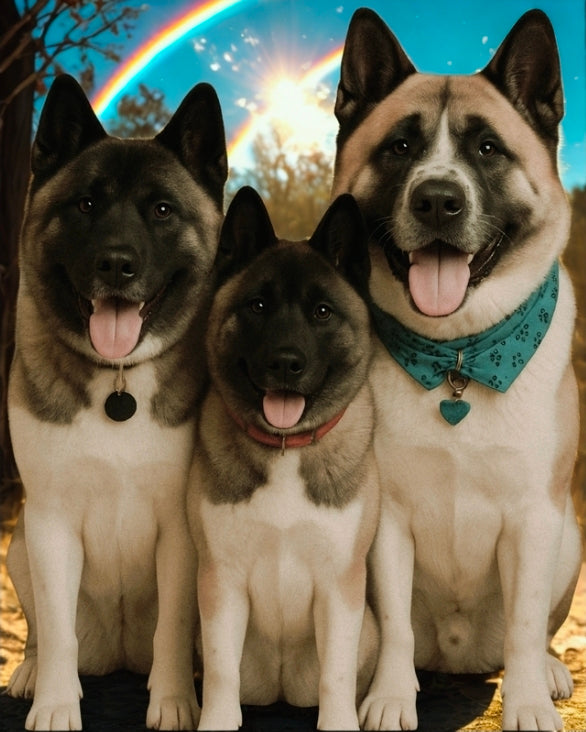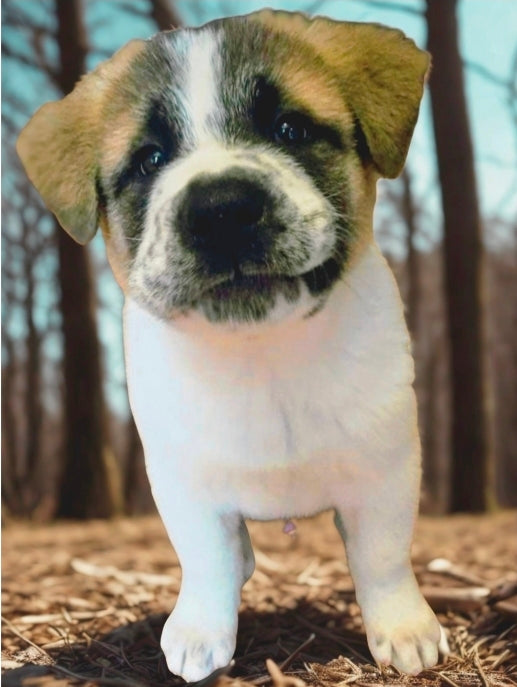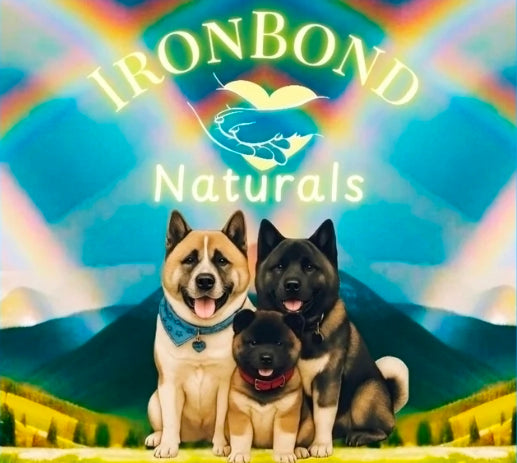How to Train your Dog by IronBond Naturals
Positive Reinforcement vs. Positive Punishment
There are three primary approaches to dog training:
• Positive Reinforcement – encouraging desired behaviors by rewarding them.
• Positive Punishment (Compulsive or Aversive Training) – discouraging undesired behaviors through fear, discomfort, or pain.
• Balanced Training – a combination of reinforcement and punishment.
While punishment can suppress undesirable behaviors, it does not teach the dog what to do instead. It can also damage the relationship between dog and handler by creating fear and mistrust. Dogs trained using aversive methods often experience confusion, frustration, stress, and anxiety. Scientific research confirms that fear-based training impairs learning, memory, problem-solving, and decision-making, and can negatively impact a dog’s temperament and emotional well-being. Given that over 90% of dog bites are fear-related, it is clear that fear-based training contributes to this serious issue.
By contrast, positive reinforcement fosters a learning environment that is enjoyable, effective, and trust-based. Just as people learn best in a supportive, encouraging setting, so do dogs. When training is fun and rewarding, dogs are more motivated to learn and engage. A respectful, trust-centered relationship is not only more humane—it’s also more successful. Positive training works, making punishment unnecessary.
The Importance of Your Dog’s Name
Your dog’s name should signal that something positive is about to happen and prompt it to focus on your next cue. Avoid using your dog’s name when correcting or scolding, as this can create a negative association and reduce the likelihood of a reliable recall. To maintain the effectiveness of the name cue:
• Say your dog’s name only once before giving a command.
• Avoid repeating the name in an attempt to gain attention, as it diminishes its impact over time.
Training Cues and Consistency
Dogs thrive on consistency and clarity. Repeating cues multiple times teaches your dog that it doesn’t need to respond the first time. To avoid this:
• Only give a cue once, and only when you are confident your dog will respond.
• Ensure your dog is set up for success—minimize distractions and avoid asking for behaviors it hasn't fully learned.
• Always follow through with your cues to reinforce that your words have meaning.
Consistency in cue delivery helps create clear communication and fosters better obedience.
Feeding Schedule
Establishing a consistent feeding schedule benefits both training and housebreaking efforts. When your dog is on a routine and food is not available at all times, treats become more motivating and effective during training sessions. A dog with a healthy appetite is more likely to be attentive and responsive to rewards.
Free-feeding—or leaving food out all day—can reduce the value of food as a training tool and make it more difficult to capture your dog’s attention. Additionally, a predictable feeding schedule makes it easier to anticipate when your dog will need to eliminate, which supports more consistent house training.
Keep in mind that the more distracted your dog is, the more appealing and aromatic the treat may need to be to regain focus.
Training Treats: A Tool, Not a Crutch
Training treats are an effective tool for shaping behavior, building reliability, and putting cues on command—but they are not meant to be used forever. Like any tool, treats serve a purpose during skill development and can be phased out once the behavior is learned.
Think of treats as a drill when assembling a table—necessary during construction, but unnecessary once the structure is stable. If reinforcement is needed again, reintroduce treats temporarily to reinforce or repair the behavior.
Motivation is essential for all learning—whether in dogs or people. While some may wish their dogs to respond “just because,” true, reliable responses come from motivation, not intimidation. Food is just one of many effective rewards. Over time, treats can be replaced with praise, play, attention, walks, or any other activity your dog values.
Ultimately, a successful training relationship is built on trust and mutual respect—not fear.
Basic Commands
Sit – Building Default Good Manners
Purpose:
This exercise teaches your dog that sitting is the key to earning what it wants. By learning to sit voluntarily—without being prompted—your dog begins to develop polite behavior and self-control.
Note: Do not use the verbal cue “sit” during this exercise. The goal is for your dog to choose the behavior on its own.
Procedure:
• Present a treat to your dog so it can see and smell it, then stand up and wait patiently.
• As soon as your dog sits voluntarily, immediately mark the behavior with your reward marker (e.g., “Yes!”) and deliver the treat.
• Step away so your dog gets up to follow you, then repeat the process.
With consistent repetition, your dog will quickly learn that sitting makes good things happen—and will begin offering the behavior regularly as a polite way of asking for attention, treats, or play.
Targeting – Teaching Focus and Luring Skills
Purpose:
Targeting helps your dog learn to follow a treat with its nose. This creates a foundation for luring the dog into desired positions (e.g., sit, down, heel) without using physical pressure or force. It also builds focus and engagement.
Procedure:
• Hold a treat close to your dog’s nose and allow it to sniff.
• Slowly move the treat from side to side or in small patterns, encouraging your dog to follow it with its head and body.
• Each time your dog follows the treat willingly, mark the behavior (“Yes!”) and reward.
This simple yet powerful exercise sets the stage for effective, force-free training and increases your dog’s ability to stay engaged with you.
Leave It – Building Impulse Control and Bite Awareness
Purpose:
This exercise teaches your dog to disengage from whatever it is focused on—whether it’s food, a person, another animal, or an object. Dogs explore the world with their mouths, often without conscious intent. Teaching your dog to control its mouth helps improve bite inhibition, increases safety, and strengthens your ability to redirect undesirable behavior.
“Leave it” is a valuable cue used in a wide variety of situations: preventing a dog from chasing a cat, sniffing at food, bothering children, eating garbage on walks, or reacting aggressively. It’s especially useful for managing reactivity in overstimulated or stressed dogs.
Procedure:
• Crouch down in front of your dog and present a treat enclosed in your hand (fist closed, palm facing the dog).
• Keep your hand steady and ignore any attempts to sniff, lick, or paw at it. Do not say “leave it” yet.
• The moment your dog pulls its nose away or loses interest, calmly turn your hand over and open your palm to give the treat.
• Repeat until your dog consistently pulls away from your hand. Once that behavior is reliable, begin saying “leave it” as you present your closed fist.
As the exercise progresses, your dog will become more deliberate and gentle, developing better impulse control and becoming more aware of its actions.
Watch Me – Teaching Focus on Cue
Purpose:
The “watch me” cue helps your dog learn to focus on you, even in distracting environments. Attention and impulse control are critical skills, especially when working through reactivity or when you need to redirect your dog in public. A dog that learns to focus on command is easier to manage and less likely to engage in unwanted behaviors like barking, lunging, or pulling.
Teaching “watch me” strengthens your dog’s mental discipline and reinforces the bond between you and your dog.
Procedure:
• Hold a treat near your dog’s nose to let it smell.
• Slowly move the treat up toward your face, ideally between your eyes.
• The moment your dog makes eye contact, mark the behavior with “Yes!” and reward with the treat.
Repeat regularly in various environments to improve your dog’s ability to focus on cue.
Basic Sit-Stay – Teaching Reliable Position Holding
Purpose:
This exercise introduces the concept of “stay,” teaching your dog to hold a position until given permission to move. The key to a strong stay is consistency and clear communication, especially regarding the release cue.
Stay Hand Signal:
Use a clear, open palm facing your dog—similar to a traffic officer’s stop gesture.
Release Cue:
A reliable stay requires a consistent and unique release cue. Choose a word or phrase you don’t commonly use in conversation to avoid confusion. Examples include “all done,” “free,” “release,” or even a phrase in another language. Avoid using commonly repeated words like “okay” or “good dog,” which may unintentionally release your dog during casual conversation.
Procedure:
• Cue your dog to sit.
• Give the “stay” hand signal and say your verbal cue (e.g., “stay”).
• Pause briefly, then give your release cue and praise your dog.
• Gradually increase the duration and distance as your dog gains confidence and reliability in holding the position.
By reinforcing the stay with consistency and patience, your dog will learn to wait calmly until released, even in distracting situations.
Setting Your Dog Up for Success
One of the most important principles in effective dog training is setting your dog up to succeed. Only ask your dog to perform tasks that it is realistically capable of completing under the current circumstances. If you create an environment that supports success, your dog will succeed. If you set expectations beyond its capacity at that moment, the likelihood of failure increases.
While your dog may have successfully performed a ten-second “stay” in a previous session, factors like health, environment, or emotional state may affect performance during the next session. Just like people, dogs have good days and bad days, and they experience varying levels of distraction.
Teaching Recall: Building a Reliable Response
A reliable recall—the ability of your dog to come when called—is one of the most important skills and enhances leash walking.
• Recall is Trained, Not Innate
• Dogs don’t automatically come when called; they must be taught that coming to you is always a rewarding experience.
• Never Punish for Coming Late
• If your dog doesn't come right away, avoid punishment. Instead, focus on building a positive association with returning to you.
• Practice Frequently
• Use a cheerful tone, a recall cue like “come,” and high-value rewards. Practice in safe, enclosed areas before moving to open spaces.
Real-World Practice: Leash Walking with Distractions
Once basic commands are reliable, incorporate them into your walks:
• Redirecting Pulling or Lunging
• If your dog pulls, stop walking. Call them to you, reward, and continue. This teaches that pulling ends the walk, while calm behavior earns rewards.
• Dealing with Distractions
• If your dog lunges or fixates on another dog or person, turn around calmly and walk the other way. Reward compliance. Avoid scolding or tugging the leash.
• Engage with Your Dog
• Talk to your dog during walks and reinforce calm behavior. This maintains connection and focus.
Why Use Treats and Rewards in Leash Training?
• Positive Association
• Treats make leash training a positive experience. Your dog learns that staying close and responding to cues leads to good things.
• Motivation
• Rewards encourage your dog to focus and participate in training, especially in new or stimulating environments.
• Communication
• Immediate rewards communicate clearly what behavior is correct.
• Reinforcement
• Repeating the pattern of cue → behavior → reward builds strong habits over time.
As your dog becomes more reliable, gradually phase out frequent treats and rely more on verbal praise, affection, or play.
Key Considerations:
• Environmental Awareness: Always consider where you are training and what distractions are present. Even familiar environments can become more challenging with added noise, new scents, or other dogs and people nearby.
• Your Dog’s Physical and Emotional State:
If your dog is unwell, in pain, stressed, anxious, or fearful, lower your expectations. Focus only on what is necessary and achievable at that time. In such cases, it may be best to avoid training altogether unless it's essential—for example, during a vet visit. In those moments, even training opportunities should be adjusted or skipped in favor of your dog’s well-being.
Distraction Levels:
Distractions come in many forms, such as new locations, sounds, smells, and sights. Something as simple as moving to a different part of the room or stepping outside can significantly increase the challenge for your dog. Remember, dogs experience the world far more intensely than we do—they hear sounds four times better and smell with incredible precision. Always consider the sensory load your dog is experiencing.
When Setting Goals, Consider:
• Your dog’s current emotional and physical state
• Its ability to focus and concentrate in that moment
• The location and its associated distractions
By adjusting your training plan based on these factors, you ensure your dog remains confident, engaged, and successful—key elements to building a strong foundation of learning and trust.


